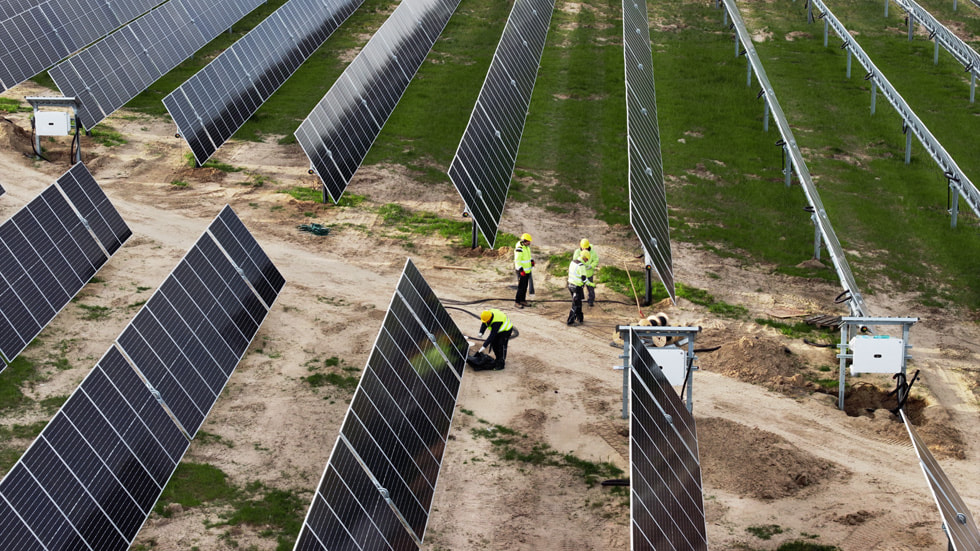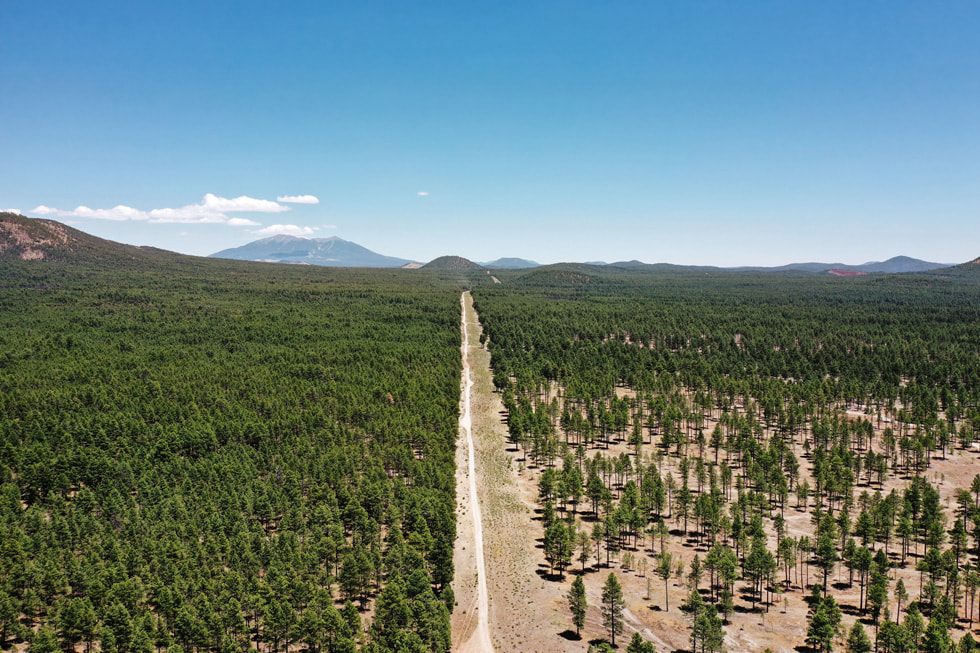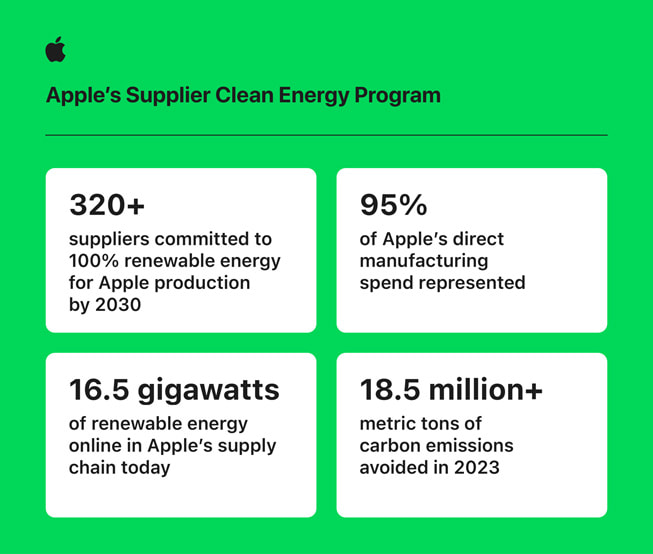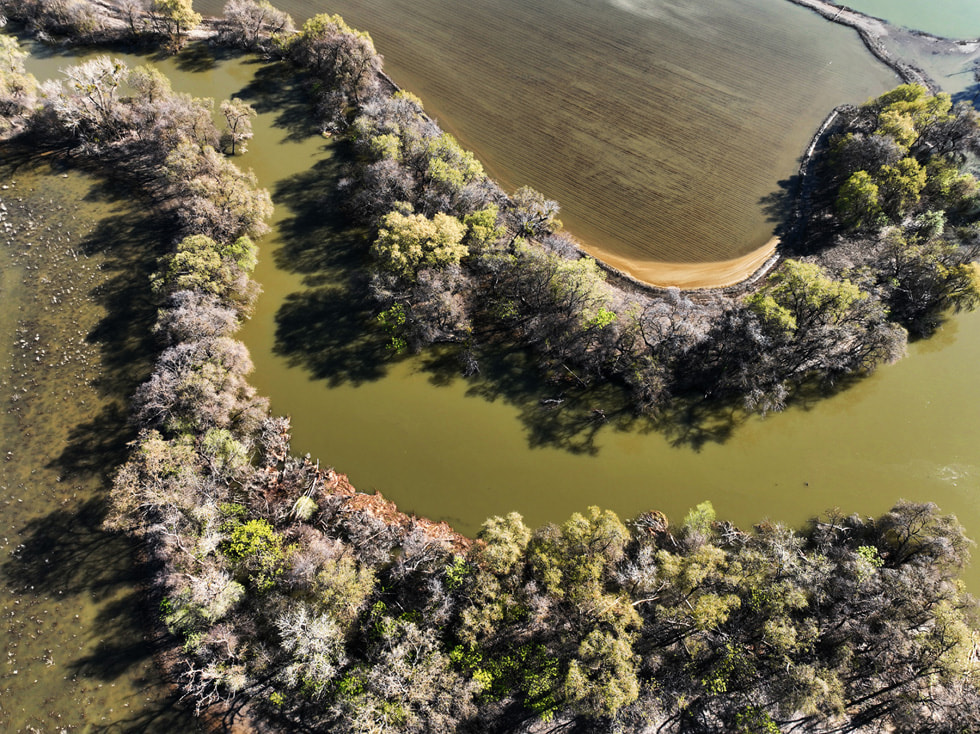UPDATE
April 17, 2024
Apple ramps up investment in clean energy and water around the world
Together, Apple and suppliers are supporting over 18 gigawatts of clean energy and delivering billions of gallons in water benefits and savings

Apple will invest directly in new solar energy around the world, including a project in Spain (shown here) with international solar development platform ib vogt.
Apple today announced new progress to expand clean energy around the world and advance momentum toward Apple 2030, the company’s bold goal to be carbon neutral across its entire value chain by the end of this decade. More than 18 gigawatts of clean electricity now power Apple’s global operations and manufacturing supply chain, more than triple the amount in 2020. Apple is making new investments in solar power in the U.S. and Europe to help address the electricity customers use to charge and power their Apple devices.
As part of its broader environmental efforts, Apple also advanced progress toward another ambitious 2030 goal: to replenish 100 percent of the fresh water used in corporate operations in high-stress locations. This includes launching new partnerships to deliver nearly 7 billion gallons in water benefits — from restoring aquifers and rivers, to funding access to drinking water — over the next 20 years. As with clean energy, Apple has extended its commitment to clean water across the entire supply chain: Together, Apple suppliers saved over 12 billion gallons of fresh water last year, for a total of 76 billion gallons in water savings since the company launched its Supplier Clean Water Program in 2013.
“Clean energy and water are foundational to healthy communities and essential building blocks for a responsible business,” said Lisa Jackson, Apple’s vice president of Environment, Policy, and Social Initiatives. “We’re racing toward our ambitious Apple 2030 climate goal while taking on the long-term work to transform electrical grids and restore watersheds to build a cleaner future for all.”
Adding New Renewable Capacity Around the World
Electricity — both to manufacture Apple products and to charge and power them — makes up the largest portion of Apple’s comprehensive carbon footprint. As part of Apple 2030, the company has called on its global suppliers to use clean electricity and become carbon neutral across all their Apple-related operations. Over 320 suppliers — representing 95 percent of Apple’s direct manufacturing spend — have led the way in the transition so far, resulting in 16.5 gigawatts of renewable energy online in Apple’s supply chain today. This generated over 25.5 million megawatt-hours of clean energy across the supply chain last year, avoiding over 18.5 million metric tons of carbon emissions.
To address the greenhouse gas emissions associated with customers using their devices, Apple has pledged to match every watt of charging electricity with clean electricity by 2030, including through large-scale investments in new renewable energy in markets around the world. This is part of a broader strategy to minimize emissions from the use of Apple products through efficiency improvements, engaging with customers around opportunities to decarbonize the grid, and building clean electricity projects that maximize carbon reductions and social impact. In the U.S., Apple is investing in a portfolio of solar projects across Michigan, with construction underway to bring 132 megawatts of clean energy online later this year. In Spain, Apple has partnered with international solar development platform ib vogt on an investment that will generate 105 megawatts of solar power when the project comes online by the end of 2024.
To address its growing corporate operations in India, Apple has also embarked on a joint venture with leading renewable developer CleanMax to invest in a portfolio of six rooftop solar projects with a total size of 14.4 megawatts. The added capacity provides a local solution to power Apple’s offices, its two retail stores in the country, and other operations in India. Apple first achieved 100 percent renewable energy for its global corporate operations in 2018.
Apple’s commitment to renewable energy has unlocked new capacity in markets around the world. In 2018, Apple took an innovative approach to connect 12 of its suppliers operating in China with renewable energy sources through the China Clean Energy Fund. The Fund has now exceeded its goal, with investments resulting in over 1 gigawatt of new wind and solar projects in China across 14 provinces. In aggregate, these projects are expected to deliver over 2,400 gigawatt-hours of renewable energy each year, equivalent to the residential power consumption of over 2.5 million people in China.
Advancing Water Resilience Through Nature-Based Solutions
Apple aims to advance water security everywhere its business reaches through collaboration across the manufacturing supply chain and innovative long-term partnerships to restore ecosystems, address community water needs, and improve climate resilience of watersheds. Since water impacts are felt locally, Apple has initiated fresh water replenishment work in some of the highest-stress locations where the company operates — including Northern and Southern California, Arizona’s Colorado River Basin, and the Indian states of Telangana and Maharashtra. Modeled after the company’s approach to renewable energy procurement, Apple is pursuing innovative strategies and long-term contracts aimed at delivering water benefits and savings across entire watersheds. Since 2023, Apple has so far committed over $8 million to replenishing fresh water in high-stress watersheds. The projects announced today are expected to deliver a combined 6.9 billion gallons of water benefits over the next two decades.
In Northern California, Apple is working with River Partners to restore the natural function of the flood plain on 750 acres where the Sacramento River, Feather River, and Butte Creek meet. This confluence of waterways — the largest in California — offers a critical resting point for native Chinook salmon along their path to the Pacific Ocean. Restoring the area will involve planting hundreds of thousands of native plants and reconnecting the vast historic flood plain, making the region and downstream communities more resilient to climate-driven flooding. Apple’s investment is expected to leverage nearly 5 billion gallons of freshwater benefits over 20 years by significantly reducing water demand on the property and encouraging healthy flood patterns to recharge underground aquifers. The restoration of Dos Rios Norte is also funded by the California Department of Fish and Wildlife, the California Natural Resources Agency, the California Wildlife Conservation Board, and the U.S. Bureau of Reclamation.

In the greater Phoenix area, Apple is working with Salt River Project to protect approximately 30,000 acres of forest at severe risk of wildfire.

With a 10-year plan to strategically thin forests in the Colorado River Basin, the project will help protect the watershed from being devastated by wildfires.
In the greater Phoenix area, home to Apple’s Mesa data center, Apple is working with Salt River Project (SRP) to protect approximately 30,000 acres of forest at severe risk of wildfire. With a 10-year plan to strategically thin forests in the Colorado River Basin, the project will help protect the watershed from being devastated by wildfires and ensure the upstream reservoir can continue to support local communities. Apple’s investment — the largest investment with SRP’s Resilient Water and Forest Initiative — is expected to deliver nearly 2 billion gallons of water benefits in the area.
LiDAR scans help to track the forest-thinning project, which is expected to deliver nearly 2 billion gallons of water benefits in the area.
Last year, Apple achieved its target for 100 percent water replenishment for the company’s corporate operations in India through its ongoing work with Uptime Catalyst Facility. In 2023, Apple’s support provided 23 million gallons of clean, affordable drinking water to communities from over 300 water kiosks run by local entrepreneurs in the innovative performance-based program. Progress in another critical region — Southern California — continues with a project to remove the invasive Arundo donax cane species in the Los Angeles River Watershed, saving 21 million gallons of water annually.
In addition to pursuing watershed restoration and other nature-based replenishment solutions in high-stress areas, Apple is committed to smart water stewardship across the business. In 2021, Apple’s data center in Prineville, Oregon, became the first-ever data center certified to the Alliance for Water Stewardship (AWS) International Water Stewardship Standard, a trusted global framework for measuring responsible water stewardship. Since then, Apple has certified four additional data centers to the Standard and supported 20 supplier sites in achieving certification as well. In the past year, seven supplier sites in southern India and over 20 supplier sites near Shanghai and Suzhou in China have participated in water stewardship training with AWS and others in the industry.
Accelerating Progress Through Green Investments
In the U.S. and around the world, Apple’s Green Bonds have also helped make these new investments possible. Last year, Apple allocated proceeds from its 2019 Green Bond toward new clean energy projects like the new solar projects in Michigan and the IP Radian Solar project in Texas, support for the Supplier Clean Energy Program, and investments in high-quality carbon removal through the Restore Fund. Since 2016, Apple has issued a total of $4.7 billion in Green Bonds, with approximately $3.4 billion allocated to date.
For more information on Apple’s Green Bond efforts, visit investor.apple.com/Apple_GreenBond_Report. This year’s annual impact report covers the cumulative allocation of Apple’s 2019 Green Bond proceeds to environmental projects that incurred spend between September 29, 2019, and September 30, 2023 — Apple’s 2023, 2022, 2021, and 2020 fiscal years. Sustainalytics provided a second-party opinion on the selected projects, and Ernst & Young LLP provided an attestation report on the spend.
Share article
Media
-
Text of this article
-
Images in this article

